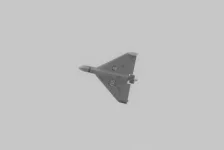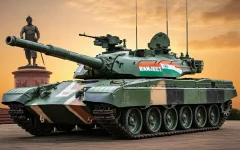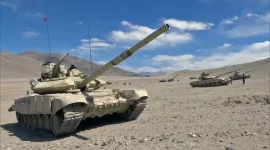- Views: 2K
- Replies: 8

India's Advanced Medium Combat Aircraft (AMCA) MkII, expected to be operational by 2032-33, is set to break new ground in aerial warfare. It will be the first fighter jet to integrate an AI-operated Heavy Unmanned Combat Aerial Vehicle (UCAV) – the Ghatak – as part of a revolutionary "family of systems" approach. This innovation signifies a major leap forward in combat autonomy and aircraft-drone coordination.
The Ghatak UCAV, a 13-ton unmanned aircraft with a stealthy flying-wing design, will be a crucial component of the AMCA MkII's arsenal. Constructed with composite materials and stealth coatings, the Ghatak will have a reduced radar cross-section, making it difficult for enemy radars to detect. This UCAV will be capable of performing a variety of missions, including:
- Suppression of Enemy Air Defenses (SEAD): Targeting enemy radar installations and air defence systems.
- Reconnaissance: Gathering intelligence and surveillance data.
- Precision Strikes: Acting as a mini-bomber to neutralize armored columns and critical enemy infrastructure.
What truly distinguishes the AMCA MkII-Ghatak pairing is the level of AI integration. The Ghatak UCAV will operate with a high degree of autonomy, making mission decisions based on real-time data and analysis. Unlike current drone systems that rely on constant guidance from a mothership, the Ghatak will utilize its onboard AI to formulate flight plans and choose attack strategies with minimal human intervention.
The AI system within the AMCA MkII will continuously feed the Ghatak UCAV the necessary data to execute its missions. The two AI systems – one onboard the AMCA MkII and the other within the Ghatak UCAV – will be in constant communication, effectively "talking" to each other to fuse data and determine the best course of action in real-time. This machine-to-machine interaction will enable them to assess battlefield scenarios and adapt their strategies accordingly, ensuring optimal mission outcomes with minimal pilot intervention.
Although largely autonomous, the Ghatak UCAV will still have a human operator overseeing its activities. However, this role will primarily involve monitoring and ensuring the system operates within predefined parameters, with the AI handling the bulk of the decision-making.
The AMCA MkII itself will be a fifth-generation fighter with advanced capabilities like stealth, supercruise, and cutting-edge avionics. It will also serve as the mothership for the Ghatak UCAV, with its onboard AI system overseeing the UCAV's mission planning, target acquisition, and tactical decisions. This AI system will be regularly updated to ensure the AMCA MkII remains adaptable to evolving battlefield requirements, further strengthening its partnership with the Ghatak UCAV.
This combination of advanced fighter jet and autonomous UCAV, working together with a high degree of AI-enabled coordination, promises to revolutionize India's air combat capabilities.



